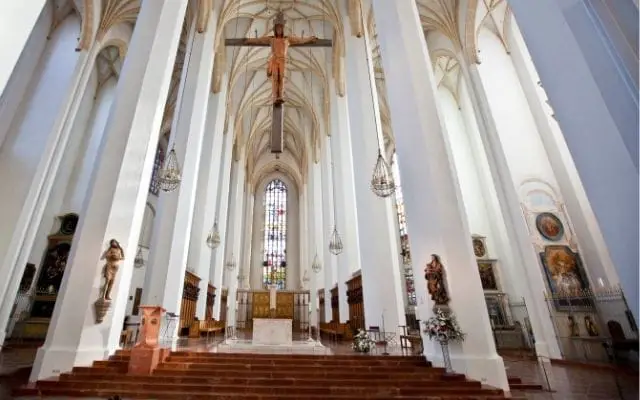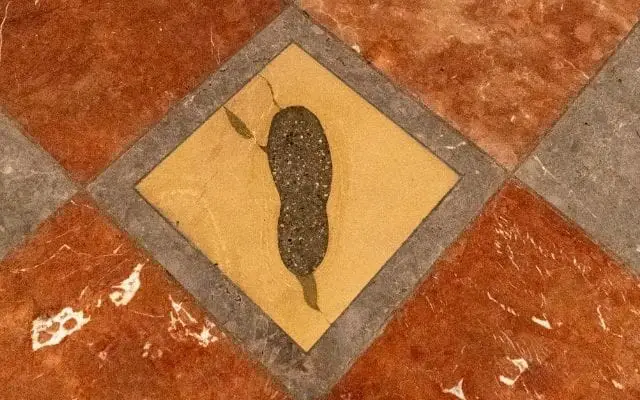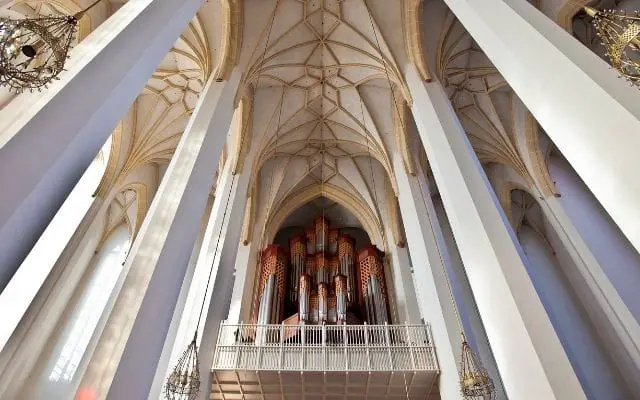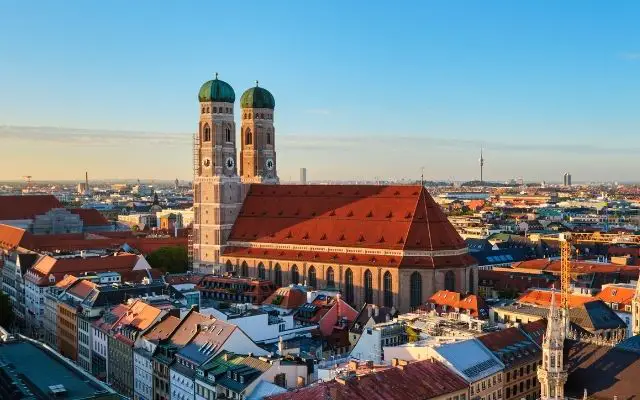The Frauenkirche Catholic Church in central Munich is the largest church in Munich and is THE ever-popular symbol of the city itself.
One of the many Catholic Churches dotted about the city, the Frauenkirche Munich could originally accommodate an astonishing 20,000 standing people.
This was an incredible number at the time and was, in fact, larger than the entire Munich population of the fifteenth century.
The church is now one of the most visited tourist attractions in Munich, is the most famous church in Munich, and is one of the most visited churches in Germany.
We hope you enjoy this brief travel guide to the magnificent Church of Our Lady and we’d love to hear your feedback in the comments below.
Munich Frauenkirche
With its two ever present onion domes, the Frauenkirche towers uncompromisingly over the city centre of the Bavarian capital, at its highest point rising 98.57 metres.
After a Munich wide referendum on building heights in 2004, it is likely to stay one of the tallest buildings in the city, at least for the foreseeable future.
With no Munich building construction permitted higher than the towers of the Frauenkirche, the vistas experienced from the viewing platform in the South Tower are expansive, stretching all the way to the Alps.
What does Frauenkirche Mean?

The full name of the Frauenkirche is actually “Dom Zu Unserer Lieben Frau”, which translates as the Cathedral of our Dear Lady.
Whilst referred to as simply “Münchner Dom” (Munich Cathedral) on the official website – locals almost always use the friendlier term of Frauenkirche when referencing Munich’s unmistakeable landmark.
Frauenkirche Munich: A Brief History
There has actually been a Catholic Church on the site of where the Frauenkirche currently stands since the 12th Century. The Frauenkirche, however, did not evolve into its current form until the 15th Century.
Thanks to the vision of bricklayer, master builder and architect Jörg von Halsbach, the Frauenkirche was constructed over the course of just 20 years, which was a remarkable accomplishment at the time.
Built between 1468 and 1488 the Munich Cathedral was erected based on a Gothic design and made use of bricks as its primary constructive material.

The fact that the exterior of the Frauenkirche was presented plainly and its structural buttresses actually hidden within its interior, ensures that the structure belies the buildings real age, making the cathedral look more-modern than it actually is.
The main building was completed in 1488 but, due to budgetary constraints, the actual towers were not completed until 1525. Original plans penned dictated that the cathedral have pointed towers (Gothic Style), but as they were completed during the European Renaissance, domes were constructed rather than spires, and a distinctive Munich landmark was born.
The domes were actually modelled in a Byzantine Style and based on the Dome of The Rock in Jerusalem. That church in Jerusalem is actually a monument of Islamic faith rather than of Christian faith. This makes the Frauenkirche distinctly unique among Catholic Churches throughout the world.
With some of the oldest Stained Glass Windows to be found in Germany the filtering light throughout the building gives off a warmth that belies its daunting size. The surviving Stained Glass depictions of Mary’s life from the medieval period in the Chancel area at the front of the church date from 1490 having been preserved during allied air raids of the city.
After suffering major damage through World War II, a multi-stage restoration was initiated on the church that was only finally completed in mid-1994. Recent renovation work has seen the entire façade cleaned and updated due to extensive damage caused from encroaching damp.

The Devils Footprint

The mystery surrounding the supposed Der Teufelstritt – The Devils Footprint – which is located in the foyer at the entrance to the Frauenkirche, is shrouded in a somewhat spurious narrative.
According to folklore a deal was struck between the devil and master builder Jörg von Halsbach, whereby the Devil would ensure that finance for the construction of the Cathedral was available, as long as the building was completed with no windows. No windows meant the church would not be able achieve Catholic consecration.
The story tells that Jörg von Halsbach totally deceived the devil by building the church in such a fashion, with deftly placed columns and internal buttresses, that windows were not visible from the entrance foyer.
By the time the Devil had cottoned onto the ruse, the church had been consecrated and the devil was now unable to enter the building proper. In a fit of anger, he stamped his foot making the dark footprint mark at the entrance, before exiting and raging outside the cathedral in the form of a furious wind in a futile attempt to bring down the structure.
Some say the wind perpetually surrounding the Frauenkirche still contains the anger of the devil and can still be felt in one form or another every day, no matter how calm the outside conditions or weather appear.
Frauenkirche Munich Tour

It’s possible to take in a private tour presented in German, English or a number of other selected languages via the several dedicated Munich Tour Groups that take in the Frauenkirche as part of their city centre walking tours.
However, if you wish to experience a personal retrospective individual tour of the cathedral, follow the Der Muchener Dom self-guided tour.
Their website displays all the major points of interest of the Church of our Lady and translates descriptive notes about each point of interest into English.
A typical tourist might spend up to an hour investigating the Frauenkirche, but those with a keen interest in religion and theology, might spend a couple of hours taking in the atmosphere and information about the church.
For reference, the major interest points of the church covered in most guided tours are as follows:
- The Devil’s Kick
- The Organ
- The Towers
- The Cenotaph
- The Interior of the Cathedral
- The Sanctuary
- The High Altar Picture
- The Machine Clock
- The Sacrament Chapel
- The Bishop’s Crypt
- The Main Chapel
- The St. Benno Chapel
Where Is The Frauenkirche Located?
Just a couple of minutes walk from Marienplatz in Munich’s City Centre is where you’ll find the much quieter Frauenplatz and the entrance to the Frauenkirche Munich.
Getting to Munich Frauenkirche
On Foot: The Munich Cathedral is located right in the city center and just off the main town square of Marienplatz. Facing the New Town Hall walk down the left side of the building before taking a left turn into Sporerstraße which will take you directly to the Frauenkirche Munich.
By Subway / U-Bahn: The Frauenkirche is easy to walk to from the Marienplatz U-Bahn station which is by far the closest underground station.
By Bus and Tram: Plenty of Munich trams and buses operate routes that pass nearby to Marienplatz.
By Train: Munich’s main rail station is München Hauptbahnhof – one of the busiest train stations in Europe. From here, it’s about a 14-minute walk to the Frauenkirche. However the S-Bahn does run right through Marienplatz station also on a number of different lines.
By Road: Much of the old city center of Munich is designated pedestrian only so if you are driving its best to park on the city’s outskirts and use public transport in order to get to the Frauenkirche. Parking close to Munich’s Cathedral is at a premium and public car parks are costly and crowded.
Munich Cathedral FAQ's
There are so many regularly asked questions about the Frauenkirche, way too many for us to list here of course.
So we’ve selected the top Frequently Asked Questions about the Munich Cathedral that will helpfully be able to give structure and purpose to your proposed visit to the Munchener Dom.
Frauenkirche Munich Opening Hours
The Munich Cathedral is generally open Monday to Saturday from 08.00am to 17.00pm.
On Sundays and public holidays the hours are from 9.30am to 17.00pm. Visits to the church are not permitted during scheduled services.
These times can vary and alternate times are often advertised during Easter, Christmas and during Lent. Checking the official website via their Calendar of Events Page would be the best advice prior to visiting Munich’s Frauenkirche.
The Frauenkirche welcomes parishioners and visitors alike.
Frauenkirch Entrance Fee
Like most churches there is no actual entrance fee to visit the Frauenkirche in Munich.
Providing you are not disturbing any worshippers or those seeking solace, you are welcome to visit the Church of our Lady almost anytime.
Frauenkirche Tower Climb
It’s only ever been the South Tower of the Frauenkirche that has been available for tourists to climb and take in the fantastic city views.
The tower, however, is currently closed (in 2021) due to ongoing renovation and construction work.
Frauenkirche Munich Mass Times
There are regular Mass services held within the Munich Cathedral so it is well advised to check the schedule before visiting the church. You can check mass times on their official website where mass times and service times are listed on their homepage.
How Many Bells Does the Frauenkirche Have?
Both the Frauenkirch’s North Tower and its South Tower contain ten belles apiece.
The earliest bell dates from the 14th Century and the newest bell is from the 21st Century. Their combination is unique and incomparable in Europe.
They all have names with the largest and heaviest bell weighing in at over 8000kg known as Susana (Salveglocke)
When Was The Frauenkirche Rebuilt?
After the completion of World War II, the Munich Cathedral had massive damage and was basically just a shell.
Renovation work began almost directly after the completion of the war and took many years to complete.
Who is The Bishop of Munich?
As the Frauenkirche is Munich’s Cathedral, clearly it must have a resident Bishop. Presently that mantle is occupied by Reinhold Marx.
Reinhold’s actual title is officially noted as the Archbishop of Munich and Freising. He was elevated to the top echelon of Catholic Church society as one of the current serving Cardinals by Pope Benedict XVI in 2010.
Frauenkirche Video Tour
Join us on this fascinating video tour throughout the Frauenkirche in Munich. It’s impossible to cover everything, of course, so we’ve just showcased the main parts of the exterior/interior in a concise walking tour. We hope you enjoy the video!
There are quite a few other churches in Munich located in the same area of the Old Town as the Frauenkirche that are also well worth a visit.
Check out St Michaels Church (Michaelskirche), St Peters Church (Peterskirche), and the St. Johann Nepomuk Church (Asamkirche).
All are within a five-minute walk of central Munich and Marienplatz.
So there you have it, our take on Munich’s famous landmark – The Frauenkirche!
Hopefully, you found value in this blog post. We’d love to hear from you in the comments if you did, and perhaps also about other topics you’d like us to write about in Munich on this blog.

